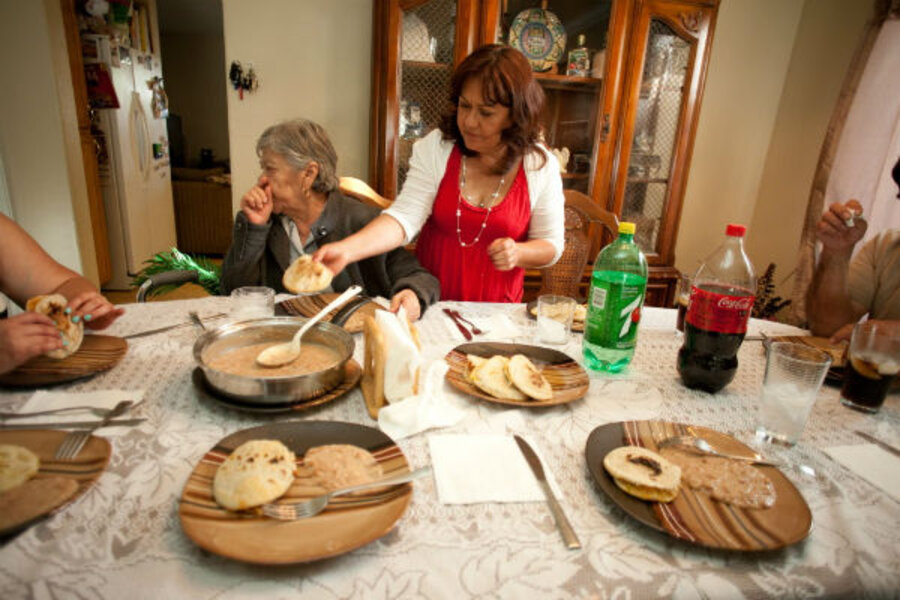Family dinner with the Gallegoses: Tortillas and togetherness
Loading...
| San Ysidro, Calif.
On the most southwesterly street in the United States, inside a shade-dappled tract house, Rosa Gallegos is in the kitchen preparing gorditas de chicharrón on a recent Saturday afternoon. Her husband, Jesus, and grown kids, Ailin and Omar, hover nearby waiting to help slice strips of cheese and stuff the little tortilla pouches with a spicy filling of pork rinds, tomatoes, and chilies.
For now, though, the kitchen is Rosa's domain. She reaches into a bowl of masa (corn dough), shapes a golf-ball-sized sphere, flattens it into a disc with a tortilla press, and cooks it on the comal (tortilla griddle).
"My mother used to make the masa at home from scratch," she says in Spanish, cocking her chin toward 85-year-old Manuela Marín, who is watching a black-and-white movie on TV. "But I just buy this from the tortillería."
PHOTO GALLERY: The great American family dinner ritual
US Census data show that among the 10 million Latino households in America – like the Gallegoses – family dinners are more common than in the general population. More than 84 percent of Latino parents with kids under age 6 report having daily meals together.
Four generations wait hungrily for Rosa's gorditas today, including Omar's wife, Mary, and their infant son, Carlo; Ailin and her daughter, Paulette, 7; and cousin Melanie Diaz, 5.
Store-bought masa is but a minor tweak of a family tradition that has remained unchanged for generations. Rosa learned this recipe at Manuela's skirts. Manuela learned it from her mother back in Durango, Mexico. Manuela's memories are fuzzy, but thinking of her own mother's cooking induces reverie over buñuelos (sweet, fried dough).
When the gorditas are done, the kids are called to put down their iPods and Barbies and come to the table. Extra stools are pulled in, and raspberry lemonade is poured. The conversation touches on borderland topics – how long was the wait at la linea (the border) today? – but is dominated by Paulette, who speaks animated Spanish, with occasional English words like "report card."
Afterward, Omar helps his grandmother to the couch and returns to linger at the table with Jesus. Mary and Ailin argue good-naturedly about who will wash dishes. The little girls scamper to the kitchen and plunge their hands into the bowl of masa to press gorditas for leftovers.
Later, Jesus wanders into his toy-strewn backyard. Not far beyond the back wall, the vibrant chaos of his native Tijuana rises over a trio of border fences festooned with concertina wire. In Jesus' 1960s childhood, there was no fence, and he recalls sneaking across the border to snatch tomatoes and cucumbers from farms on the US side before his grandmother called him and his cousins into the house for dinner.
"People here aren't used to eating together," he says. "Kids come home after school and they eat what they want. They don't wait for everybody to sit together. With Latino customs, there's more communication; you feel more relaxed with the support of your family. If someone has a problem, you can vent about it; but if you sit and eat alone, you keep your stress inside."





